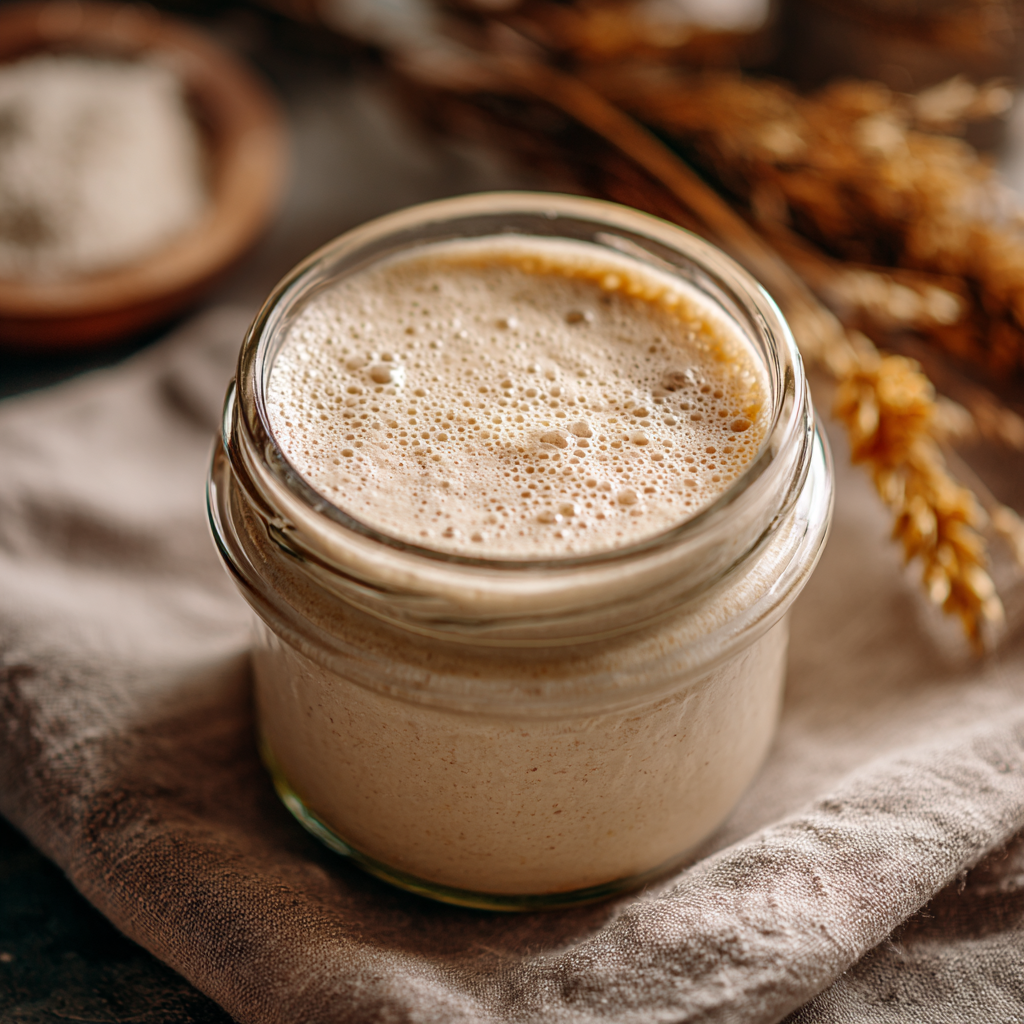Why You’ll Love This Recipe
Sourdough Starter is the foundation for creating flavorful, naturally leavened breads with a slightly tangy taste and chewy texture. Unlike commercial yeast, this living culture of wild yeast and bacteria transforms simple ingredients into artisan-style loaves. With just flour, water, and a little patience, you can cultivate a starter that lasts for years and enhances every bake.
ingredients
(Tip: You’ll find the full list of ingredients and measurements in the recipe card below.)
unbleached all-purpose flour or whole wheat flourfiltered or dechlorinated water
directions
Day 1:
In a clean glass or plastic container, mix ½ cup flour with ¼ cup water. Stir until smooth and no dry flour remains. Cover loosely and leave at room temperature (70–75°F/21–24°C).
Day 2:
You may see a few bubbles—this is a good sign. Stir the mixture and cover again. No need to feed yet.
Day 3:
Discard half of the starter. Add ½ cup flour and ¼ cup water to the remaining half. Stir, cover loosely, and let sit at room temperature.
Day 4–6:
Repeat the discard and feed process once daily. The starter should become bubbly, rise in volume, and have a pleasantly sour aroma.
Day 6–7:
When the starter doubles in size within 4–6 hours of feeding and has a strong, tangy smell, it’s ready to use. You now have an active sourdough starter.
Label and refrigerate when not in daily use. Feed once weekly to maintain.
Servings and timing
This recipe yields about 1 cup of active starter.
Initial fermentation: 6–7 days
Daily maintenance: 5 minutes
Total time: 1 week (with ongoing care)
Variations
Use whole wheat or rye flour for more active fermentation.
Add pineapple juice on Day 1 for a pH boost (optional).
Split your starter to try different flours or hydration levels.
storage/reheating
Store starter in a jar in the refrigerator when not in use.
Feed weekly with equal parts flour and water by weight.
To revive, feed at room temperature for 1–2 days until bubbly and active.
FAQs
Why isn’t my starter bubbling?
Try moving it to a warmer spot, use whole grain flour, or ensure your water is chlorine-free.
How do I know it’s ready?
It should double in size within 4–6 hours of feeding and pass the “float test” (a spoonful floats in water).
Do I always need to discard?
Yes, to keep the acidity balanced and prevent overgrowth.
Can I bake with discard?
Yes, use it in pancakes, crackers, or muffins—just not for leavening.
Can I freeze my starter?
Yes, for long-term storage. Thaw and feed several times before use.
How long does it last?
Indefinitely with regular feeding.
Can I use metal utensils?
Yes, stainless steel is fine—just avoid reactive metals like copper.
What if it smells bad?
A sour smell is normal, but if it smells like rot or cheese, discard and start over.
Can I make gluten-free starter?
Yes, use brown rice or buckwheat flour instead.
Why does it form liquid on top?
That’s “hooch”—a sign it’s hungry. Stir it in or pour it off before feeding.
Conclusion
Sourdough Starter is a living, breathing part of your kitchen that rewards care with delicious, artisanal breads. With just flour, water, and daily attention, you’ll create a bubbling, tangy culture that unlocks the magic of natural fermentation. Start today and enjoy a lifetime of real sourdough baking.
Print
Sourdough Starter
- Prep Time: 10 minutes (initial setup)
- Cook Time: 0 minutes
- Total Time: 7 days (fermentation process)
- Yield: 1 sourdough starter (about 1 cup) 1x
- Category: Basics
- Method: Fermenting
- Cuisine: Global
- Diet: Vegan
Description
A sourdough starter is a natural leavening agent made from flour and water, cultivated with wild yeast and bacteria. It forms the base for sourdough bread, giving it its signature tangy flavor and chewy texture.
Ingredients
- 1/2 cup (60g) whole wheat or all-purpose flour
- 1/4 cup (60ml) water, filtered or dechlorinated
Instructions
- Day 1: In a clean glass jar or container, mix 1/2 cup flour with 1/4 cup water. Stir well until no dry flour remains. Cover loosely and let sit at room temperature (65–75°F) for 24 hours.
- Day 2: Check for any bubbles. Discard half of the mixture (about 1/4 cup), and feed with 1/2 cup flour and 1/4 cup water. Stir, cover loosely, and rest at room temp.
- Days 3–6: Continue daily feedings: discard half and feed with 1/2 cup flour and 1/4 cup water. By day 4 or 5, the starter should begin to rise, bubble, and have a tangy aroma.
- Day 7: The starter should double in size within 4–6 hours of feeding and have a pleasantly sour smell. It’s now ready to use in baking.
- Storage: If baking daily, keep at room temperature and feed daily. For less frequent use, store in the refrigerator and feed weekly.
Notes
- Use non-chlorinated water to avoid killing wild yeast.
- Clean utensils and containers are essential to prevent contamination.
- Switch to all-purpose flour after the starter is active if preferred.
Nutrition
- Serving Size: 1 tablespoon
- Calories: 30
- Sugar: 0g
- Sodium: 0mg
- Fat: 0g
- Saturated Fat: 0g
- Unsaturated Fat: 0g
- Trans Fat: 0g
- Carbohydrates: 6g
- Fiber: 0g
- Protein: 1g
- Cholesterol: 0mg


Your email address will not be published. Required fields are marked *